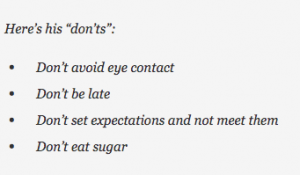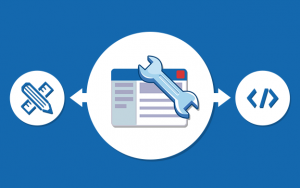— January 7, 2019

Feeling stuck at your agency? You might be using “over-coupling” as a defense mechanism to avoid something else. The solution? A coaching strategy I call “decoupling.”
As humans, we frequently get stuck because we choose to make one thing falsely contingent on another.
For example, you might say: “I’ll fire the Wet Twine employee once our client workload gets less busy.”
The reality? Running an agency rarely gets less ‘busy’… or if it does, we create a new “Well, not until…” excuse.
If this sounds familiar, you’re using a defense mechanism—a concept I call “over-coupling.”
To coach clients through this, I use a concept I call “decoupling.” Today, I’ll share how to use this agency coaching technique—including 8 tips you can use on a DIY basis.
How to Recognize Coupling
Coupling happens when you view one activity as dependent on another happening first. For example:
- “Once X happens, I’ll do Y.”
- “When I finish X, I’ll start Y.”
- “I can’t do Y until I finish X.”
Coupling is often logical—but creating unnecessary coupling (what I call “over-coupling”) can hurt your agency’s progress by adding self-imposed delays.
Over-coupling is a defense mechanism—an iteration of “all-or-nothing” thinking. (The technical psychology term for the cognitive distortion is “splitting.”)
In the rest of this article, we’ll look at when coupling makes sense, when it doesn’t make sense, and eight tips to fix things when you’ve “over-coupled” activities at your agency.
Coupling Things Sometimes Makes Sense…
Sometimes, coupling makes sense. For example:
- Project Management: “Don’t start client implementation until we’ve finished the client strategy.”
- Finance & Recruiting: “Don’t hire my next employee until I’m fairly confident my agency will get a good ROI.”
- Business Strategy: “Don’t open that third office until I’ve worked out the kinks with running the second office.”
Those are all reasonable coupling choices—jumping to Y before the X means you’d put your finances (or your client results) at risk.
… But Over-coupling Can Trap You
In my experience, coupling is too-frequently a recipe for getting stuck or overwhelmed—usually because the coupling was not truly necessary in the first place.
Unnecessary coupling may be the root cause of your getting stuck or feeling overwhelmed. Why? Because sometimes, you don’t need to finish everything before you move forward. Instead, you’re using the [over-]coupling as a defense mechanism.
Here are common excuses I hear from agency owners who are over-coupling:
- “Landing <HugeClient> will fix my profitability problems.”
- “Hiring a new salesperson will fix our lead-gen problem.”
- “I’ll take a vacation once I finally get my work under control.”
- “I can’t grow the agency until I recruit a business partner.”
- “We should wait until next quarter to do X, when things will be less busy.”
- “I don’t want to do self-marketing right now; we’re too busy with client work already.”
Don’t delude yourself. For instance, next quarter likely won’t be any less ‘busy’ than you are today. Slacking on your pipeline today means it’ll be dry in 6-12 months… and then you’ll feel desperate. And you need to fix lead-gen regardless of whether you hire a salesperson.
You might have this problem in your personal life too. When I did Weight Watchers several years ago, the group leader shared a model around what to do if you have a “bad” day and eat more than you planned (which people frequently use as license to stop tracking altogether). She said, “If you accidentally dropped a dish, you wouldn’t use that setback to trigger smashing all of the dishes.”
Fortunately, there’s a solution to this “all or nothing” linking problem at your agency!
Solution: Decouple Certain Activities

Ready to get unstuck? It’s time to decouple the unnecessarily items you linked. (Read on for 8 tips on making it work.)
My recommendation? Decouple the two unnecessarily-coupled activities. That is, declare that the second activity won’t be dependent on completing the first. This frees you to do the second thing without waiting on a first that may never happen.
It’s a mental trick of sorts—you’re re-programming what you believe to be true. (In this case, it’s a false belief—you may have thought they were linked, but that’s not really true.)
Whether you call it “decoupling” or “un-coupling” or “de-linking,” the idea is that you eliminate the self-created blockage that’s stopping you from doing the second thing.
8 Tips to Apply Decoupling at Your Agency
Here are eight tips to help you get better results at your agency! These include things I’ve used with my clients or in my own business to get unstuck.
1. Monitor when something’s taking a lot longer than you expected. This may be a sign that you’ve unconsciously coupled things. You might be “yak shaving“—where you can’t do X until you do Y, but you can’t do Y until you do Z, but you can’t do Z until…
By realizing this, you can “stop” yourself and reset the precedents and dependencies. (That’s partly why people can’t easily PM themselves—we don’t have that perspective on our selves.)
2. When you notice you’re stuck, inventory the precedents. Shortcut: Look for anything that’s “Once X, I’ll do Y” or “When X happens, I’ll do Y.” Once you have your “inventory” of coupled tasks, you can decide whether anything needs to be uncoupled.
3. Uncouple things that never should have been coupled in the first place. Uncoupling things that you’ve unnecessary coupled helps make your agency’s systems less-complex, in line with the excellent advice in Meltdown: Why Our Systems Fail and What We Can Do About It.
For instance, one of my clients was preparing for potential cost cutting next year, in case he didn’t meet his revenue targets. He was considering layoffs… starting with Wet Twine employees.
I suggested he fire the poor performers, rather than framing a termination as a layoff. That is, their continued poor performance is sufficient justification to end their employment.
After making those decisions, you still may find you need layoffs for financial reasons… but don’t commingle individual performance vs. company-wide finances.
4. Loosen the coupling when something isn’t black and white. Even when something should be coupled, be sure you aren’t making the coupling too tight.
Maybe you’d normally wait for $ 500K in new revenue before hiring a particular role… but you find a perfect-fit candidate when you’re at $ 400K in new revenue. It may make sense to hire them now—or it might make sense to wait.
The key is that you step back to review what makes sense given the current and forward-looking information.
5. Create backup plans. If something’s rightly coupled but the precedent falls through, do you have a Plan B?
For instance, if a project timeline is dependent on finding staffing, what will your operations manager do if their go-to freelancer isn’t available? What if the backup isn’t available? (That’s why you build a “stable” of freelancers, and pad your turnaround ETAs.)
6. Use tools to remind you if a precedent is delayed. Your PM tools and the Boomerang email plugin are helpful for this.
For instance, I wanted to do coffee with a contact before a client on-site. I knew I’d fly-in the day before the on-site, but coffee determined if I’d do a morning or afternoon flight. I emailed my contact, with the message Boomeranging back in a week if she didn’t respond—since I didn’t want to wait too long to book the flight. (She replied a few hours later to confirm on coffee, and I emailed my travel agent to book the morning flight—but I was covered in case she hadn’t responded promptly.)
7. Ask your team if the agency has unnecessary couplings. Your employees likely have a clear picture of where things stand. They’ll also see problematic couplings that you hadn’t intended, but that may have arisen because agencies are a complex system of complex systems.
If you make yourself vulnerable, your employees can also point out when you are coupling things unnecessarily in your own work. I seek feedback on this from my team, my coach, and my therapist.
8. Choose when to intentionally break the “rules.” These tips are guidelines, not dogmatic rules. For instance, it’s OK to make some “low hanging fruit” tactical recommendations to a client before you finish creating their full strategy. (Just be fairly sure the tactical recommendations won’t create conflicts with the TBD future strategic ones!)
During one of my employee Culture Surveys, an anonymous employee noted the coffeemaker was always breaking. (The owners didn’t drink coffee, so they weren’t experiencing this directly.) Before my final report, I advised the partners to buy a new coffee maker.
The coffeemaker wasn’t a strategic recommendation—but following that tactical recommendation would make someone really happy, for just $ 100.
Using Task-Decoupling At Your Agency
Try the tips above—you’ll likely see a positive impact!
What if decoupling doesn’t get you unstuck?
Does decoupling always work? No—sometimes it becomes clear that someone doesn’t truly want to change, or there’s another blockage that goes beyond what coaching can help. Once that becomes clear in my coaching, I recommend they work with a therapist first.
If that sounds like you, consider working with a therapist who specializes in Cognitive Behavioral Therapy (CBT). I’m not a medical professional, of course—but the Journal of the American Medical Association (JAMA) describes CBT as “the gold standard for psychotherapy.”
QUESTION: What’s one thing you can you decouple this week?
Image credits (via Creative Commons): Couplers by Shankar S. and Coupler by Pete Markham.
Business & Finance Articles on Business 2 Community
(73)
Report Post







